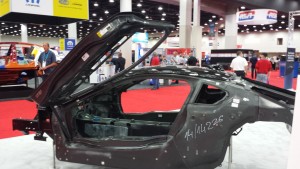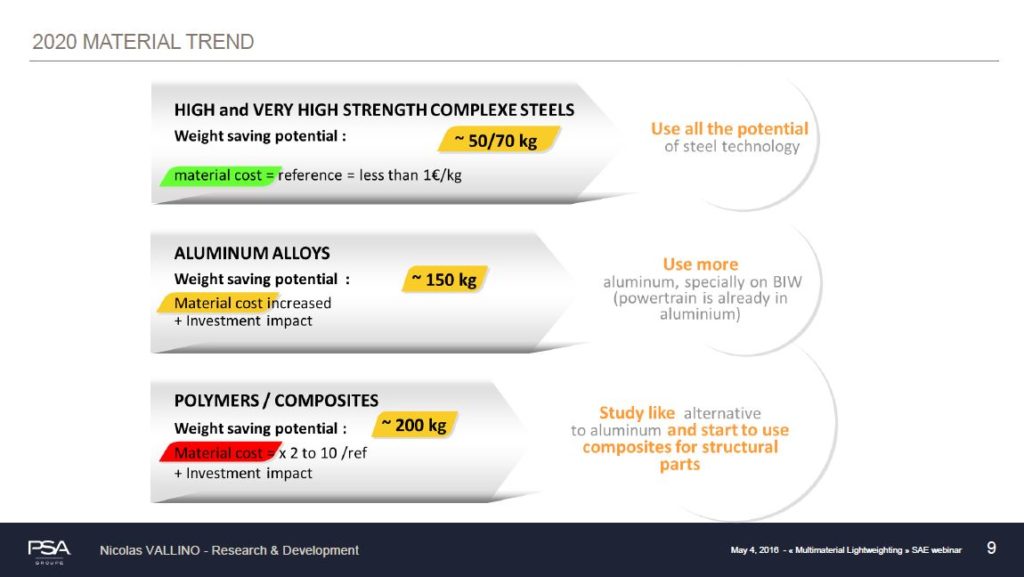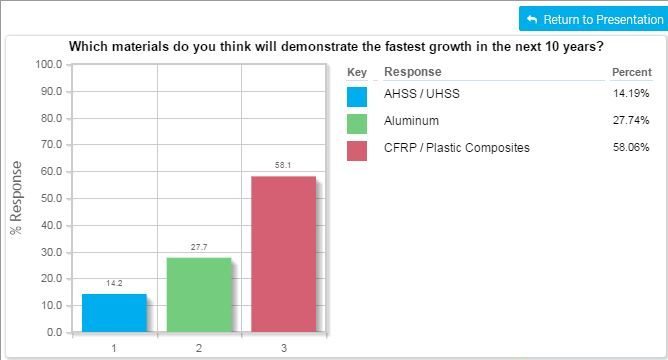
Peugeot expert: Carbon fiber, composites are the future of lightweighting
By onEducation | Market Trends | Repair Operations | Technology
Carbon fiber and other composites will be the future of automotive lightweighting, a Peugeot expert told a Society of Automotive Engineers webinar audience Wednesday.
“We will be forced to use them (composites)” mid- to long-term, PSA Peugeot Citroën numerical crash simulation methods specialist Nicolas Vallino said. (See his presentation slides.)
Meeting the “antagonistic” demands of lower emissions and increased safety will demand it, particularly as regulations worldwide for both converge on the “most severe” rules.
Near-term, OEMs can maximize steel for 110.2 to 154.3 pounds of savings at around $0.52/pound, Vallino said. Replacing more of the vehicle with aluminum was another step — particularly on the body-in-white, he said — for about 330.7 pounds, though it’d be more expensive.
Looking at alternatives for aluminum (possibly a reference to magnesium?) and using carbon fiber and composites for structural parts would cost between 2 to 10 times more but could cut 440.9 pounds.
Vallino appeared to be referring to the maximum average weight loss possible by replacing the same parts with different materials, rather than a mixed-materials vehicle which wound up 800 pounds lighter by employing all three.

Ducker Worldwide automotive and materials director Abey Abraham, also a participant in the webinar, described a need to shed an average of 470 pounds a vehicle to meet 2025 U.S. CAFE standards.
“It is essential to work on this from now,” Vallino said of the third option.
Even if this method wasn’t quite ready for use on vehicles, “we will have no choice.”
“Without any doubt, the use of composite materials in mass production will be a real revolution for automotive industry,” Vallino said.
Pulling such lightweighting off will require a collaboration of OEMs, academics, software engineers — modeling will be key, he said — and suppliers, according to Vallino.
Abraham said Ducker’s research was more bearish, finding carbon-fiber too cost-prohibitive in the near term compared to aluminum and steel. However, he noted that depending on how close an OEM sits to that 54.5 mpg-by-2025 CAFE standard, “the willingness may shift accordingly.”
The audience seemed to agree with Vallino. An informal poll of the webinar (unfortunately, the number of participants wasn’t disclosed, so treat the data accordingly) found strong support for carbon-fiber making a dent — and quickly.

Long-term, NanoSteel automotive engineering Vice President Tad Machrowicz at the March Automotive Megatrends USA conference shared Vallino’s sentiment: Even structural parts would go carbon-fiber, he said.
“It’s hard for me as a steel guy to … say that, but I think I have to say that,” Machrowicz said then.
Vallino said that OEMs would have to build multiple applications — such as safety combined with noise, vibration and harshness management — into a single carbon-fiber/composite part (or any other “innovative” material). It was unclear if he mean this was an engineering demand or to ensure the biggest bang for carbon fiber’s price.
Other issues came into play when replacing steel with such materials, he said.
“We have to think how it will be repaired by the consumer,” he said, and end-of-life recycling was also a concern.
More information:
“Multimaterial Lightweighting”
Society of Automotive Engineers, May 4, 2016
“Lighter and Safer : a challenge”
PSA Peugeot Citroën via SAE, May 4, 2016
Images:
The body of the carbon-fiber BMW i8 is on display at NACE 2015. (John Huetter/Repairer Driven News)
PSA Peugeot Citroën numerical crash simulation methods specialist Nicolas Vallino presented this analysis of materials used for automotive lightweighting at a SAE webinar on May 4, 2016. (Provided by Peugeot via SAE)
A Society of Automotive Engineering webinar poll — the number of participants was unknown — picked carbon-fiber and polymers to have huge near-term growth on vehicles. (Screenshot from SAE webinar)
